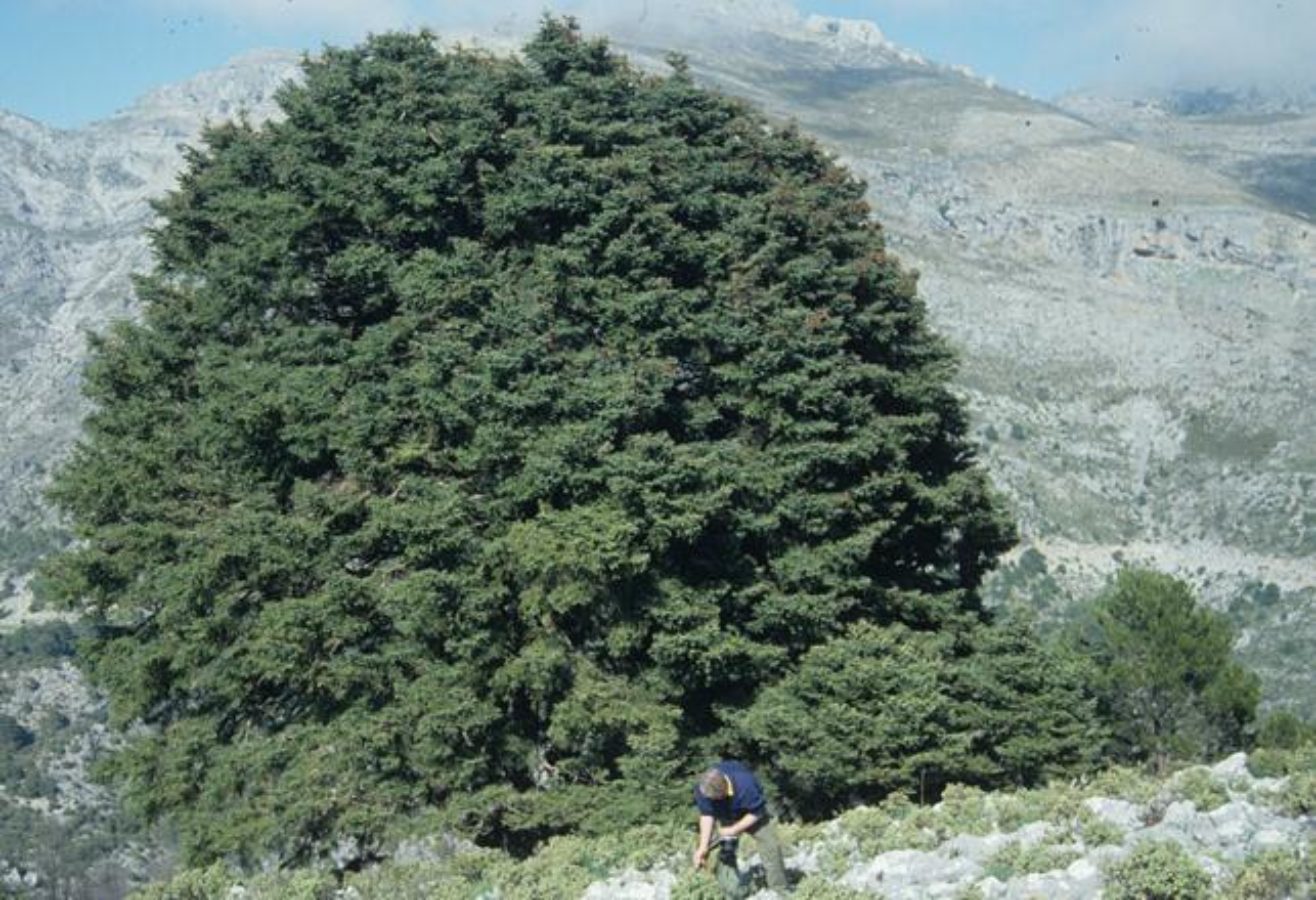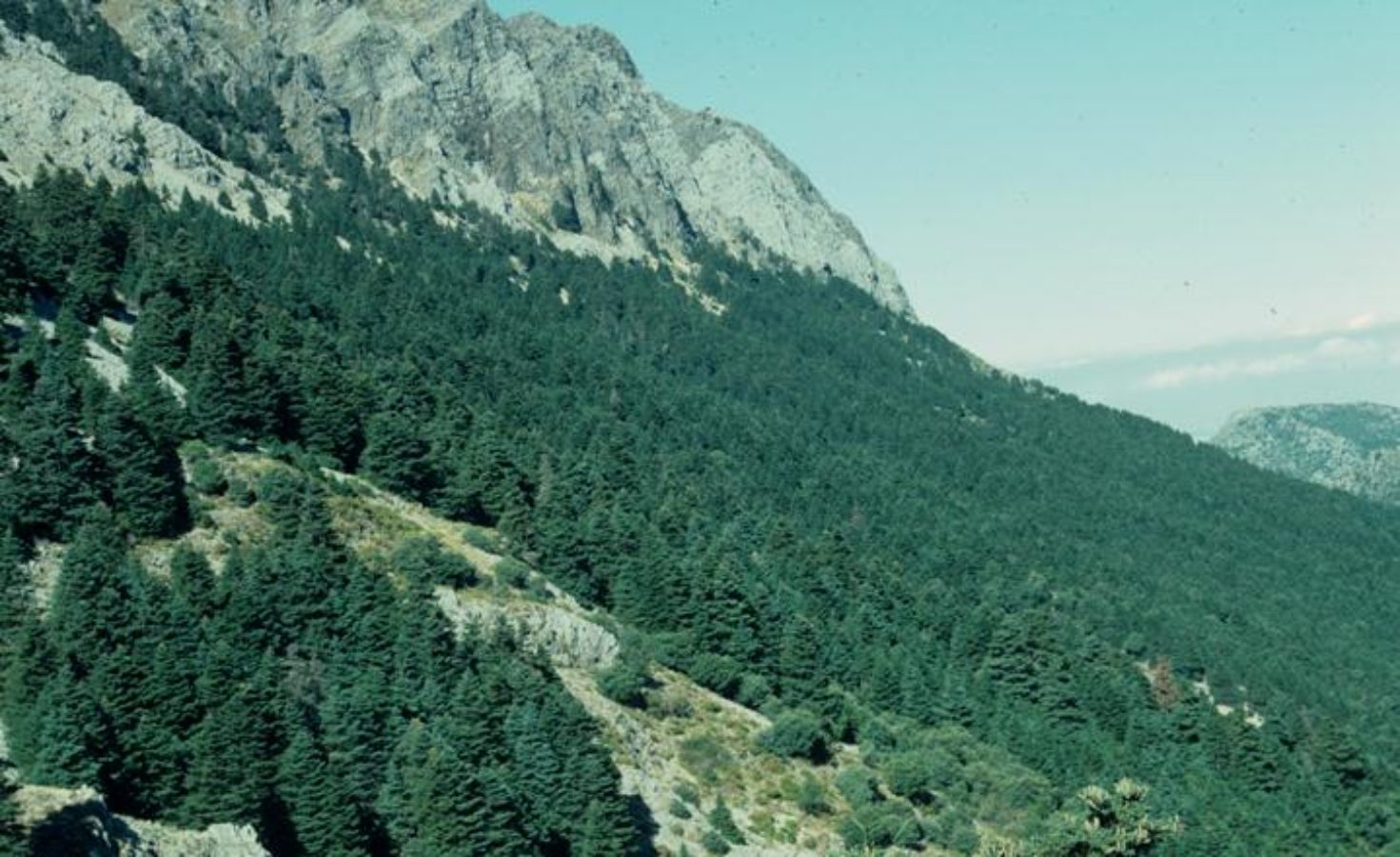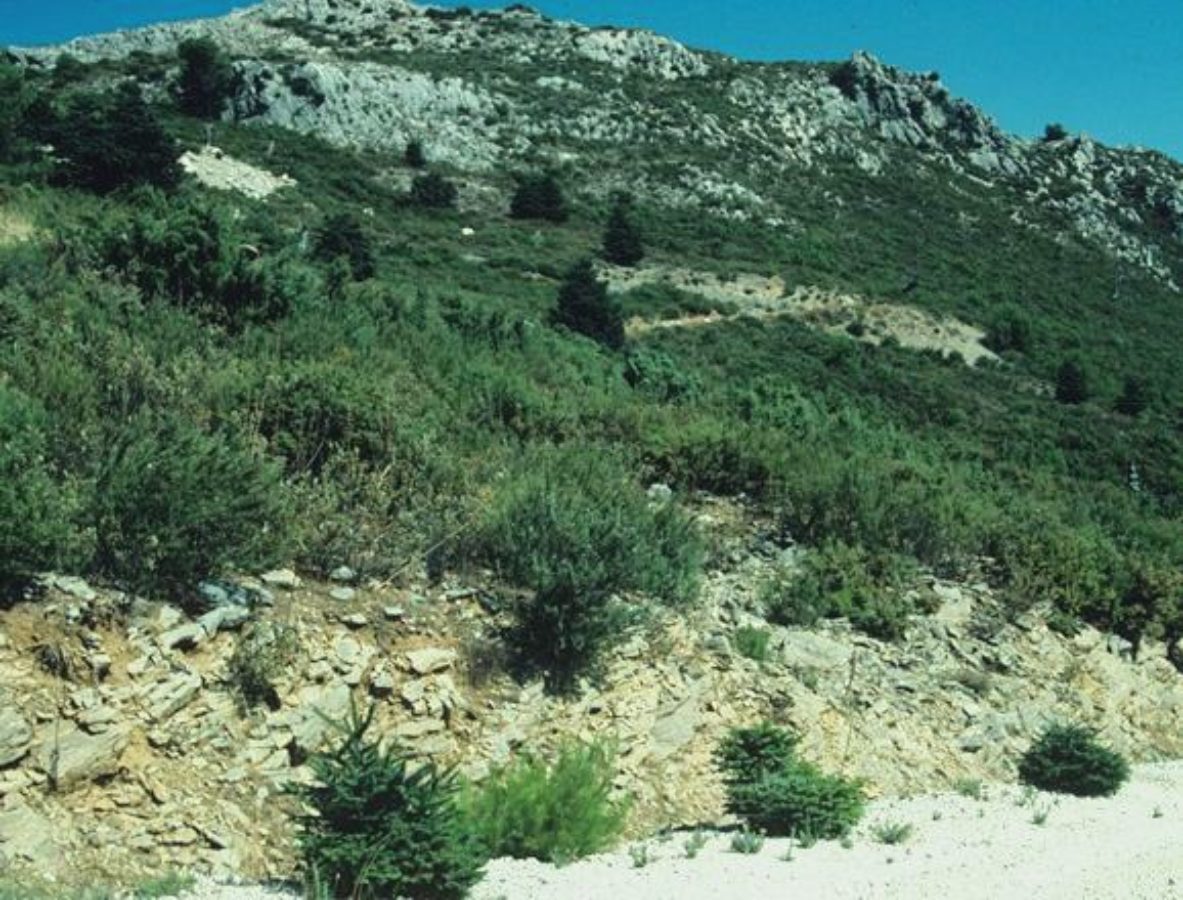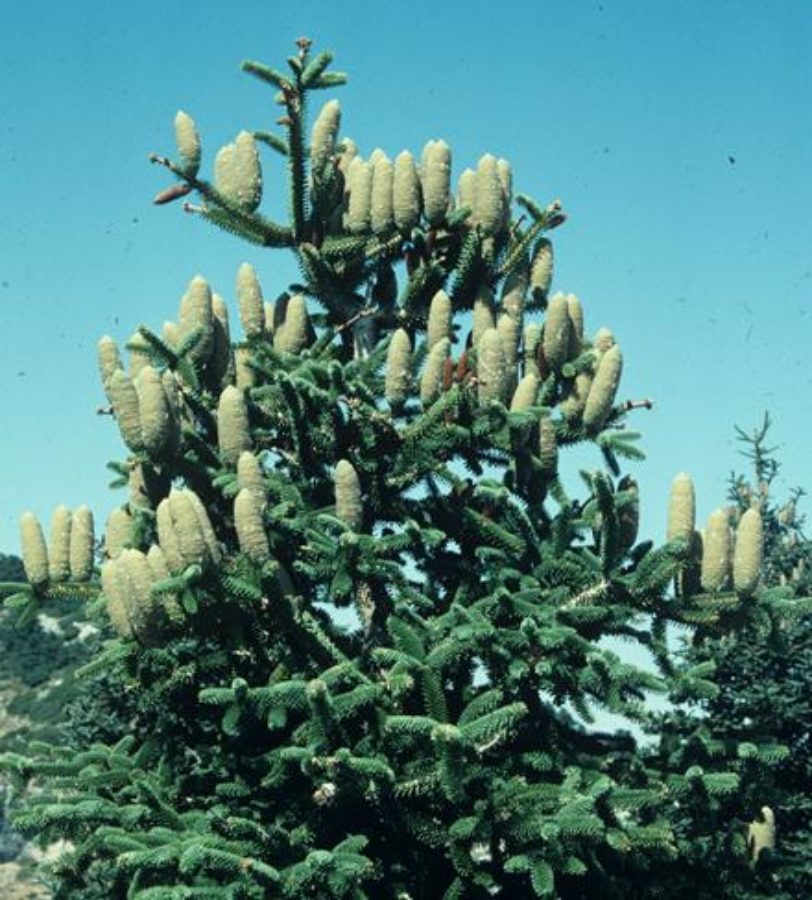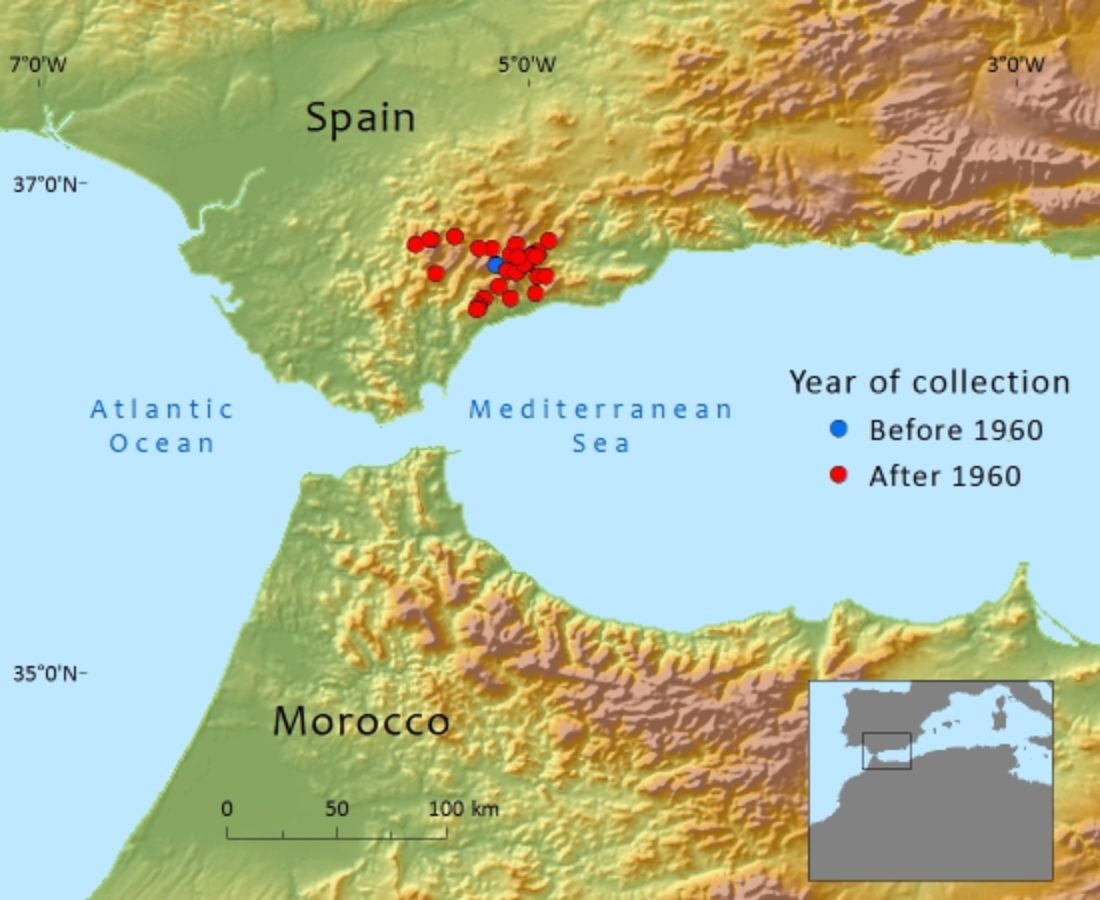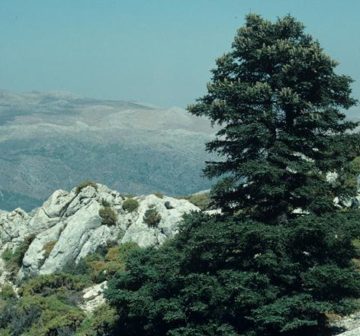Pinaceae
Abies pinsapo var. pinsapo
One of two varieties of the Spanish fir restricted to three areas of southern Spain where in the last 45 years large areas of forest have been lost mainly as a result of fire.
Description
Habit
Tree to 30m tall, d.b.h. 1–1.5m; trunk straight but sometimes forked or twisted; crown narrowly conical in young trees and irregular in mature trees. Bark smooth and dark grey in young trees, rough and scaly in old trees. Branches, lower curved downwards, uppermost ascending, branchlets very rigid, reddish brown or greenish brown, vegetative buds ovoid–globose, 5–-6 x 4–4.5mm, greenish to purple-brown
Foliage
Leaves spirally arranged all around shoot radially and perpendicularly from the shoot, those below bent backwards; 1–1.8cm, leathery, stiff, bluntly rounded (fully exposed); dull grey-green or blue-grey with two broad stomatal bands of grey-green or dull bluish white on each surface.
Cones
Female cones 9–14cm x 3–4cm, abruptly narrowed to apex, greenish purple when immature, ripening dark or light brown. Male cones crowded along underside of shoot, dark brown, opening cherry–red.
Notes
This is one of two varieties, the other being A. pinsapo var marocana (treated on a seperate page), which is native to north Morocco. The differencies between these two varieties is slight; in var. marocana the leaves are arranged around the shoot pectinately and not radially and perpendicularly from the shoot as in var. pinsapo. The female cones in the var. marocana are much larger, 10–18 x 3.5–5cm.
Human Uses
The timber has historically been locally used for house construction. The forests in the Sierra del Pinar were managed for timber production but there is no present-day use of the timber.
References and further reading
- Arista, M. (1995). The structure and dynamics of an Abies pinsapo forest in Southern Spain. Forest Ecology and Management. 74: 81–89.
- Arista, A., Knees, S. & Gardner, M. 2011. Abies pinsapo var. pinsapo. In: IUCN 2012. IUCN Red List of Threatened Species. Version 2012.2. . Downloaded on 07 March 2013.
- Arista, M., Herrera, F.J. & Talavera, S. (1997). Biología del Pinsapo. Junta de Andalucía, Consejería del Medio Ambiente, Seville, Spain.
- Arista, M., Talavera, S. & Herrera, F. J.(1997). Abies pinsapo: a protected especies in a protected area. Bocconea. 7: 421-436.
- Barbero, M., Bonin, G., Loisel, R. & Quézel, P. (1990). Changes and disturbances of forest ecosystems caused by human activities in the western part of the Mediterranean basin. Vegetatio. 87: 151–173.
- Barbey, A. (1931). A Travers les Forêts de Pinsapo d’Andalousie: Étude de Dendrologie, de Sylviculture et d’Entomologie Forestière. Librairie Agricole, Paris, France.
- Esteban, L. G., De Palacios, P., Guindeo, A. & García Fernández, F. (2007). Comparative anatomy of the wood of Abies pinsapo and its two Moroccan varieties. IAWA Journal. 28: 285–298
- Esteban, L. G., De Palacios, P. & Rodriguez-Losada Aguado, L. (2010). Abies pinsapo forests in Spain and Morocco: threats and conservation. Oryx 44(2): 276-284.
- Génova, M. (2007). El crecimiento de Abies pinsapo y el clima de Grazalema: aportaciones dendroecológicas. Investigación Agraria: Sistemas y Recursos Forestales. 16: 145–157.
- Herrera, J., Arista, M. & Talavera. S. (1999). Abies pinsapo Boiss. In Blanca G. et al. (eds.) Libro Rojo de la Flora silvestre amenazada de Andalucía. Tomo I: especies en peligro de extinción. Consejería de Medio Ambiente, Junta de Andalucía.
- Knees, S.G. 2011. Phylogeny, Systematics and Conservation of Abies, especially those around the Mediterranean Basin. Reading. Unpublished PhD Thesis, University of Reading.
- Linares, J. C. & Carreira, J. A. (2006). El pinsapo, abeto endémico andaluz. O, ¿qué hace un tipo como tú en un sitio como éste? Ecosistemas. 3: 171–191.
- Linares, J. C. (2008). Efectos del cambio global sobre la dinámica poblacional y la ecofisiología de bosques relictos de Abies pinsapo Boiss. PhD Thesis, Universidad Jaén, Jaén, Spain.
- Linares, J. C., Camarero, J. J. & Carreira, J. A. (2009). Interacting effects of changes in climate and forest cover on mortality and growth of the southernmost European fir forests. Global Ecology and Biogeography. 18: 485-497.
- Terrab, A., Talavera, S., Arista, M., Paun, O., Stuessy, T. F. & Tremetsberger, K. (2007). Genetic diversity at chloroplast microsatellites (cpSSRs) and geographic structure in endangered West Mediterranean firs (Abies spp., Pinaceae). Taxon 56(2): 409-416.
- Soto, D. (2006). Núcleos residuales de pinsapo perdidos en Andalucía en el siglo XX. Investigación Agraria: Sistemas y Recursos Forestales, Special issue. 79–86.

